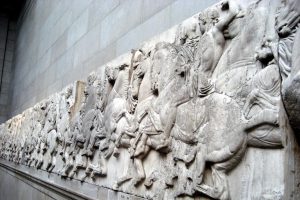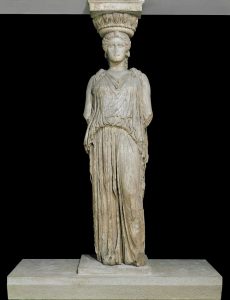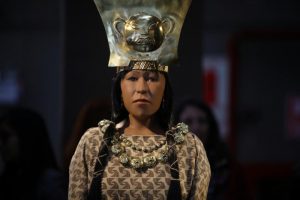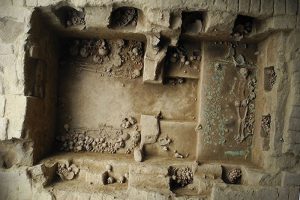The Rosetta Stone of Egypt, the Koh-i-Noor Diamond of India, the Parthenon Structures of Greece—time and time again, artifacts find themselves in the hands of a place other than their origin. Better known as the “Elgin Marbles,” these Greek treasures were named after Britain’s Lord Elgin who acquired the pieces from Athens in the early 19th century as an ambassador to the Ottoman Empire, going on to sell them to the British Parliament—of which they still reside in today (Sánchez 2017). The cultural patrimony of objects like the Parthenon Structures for the Greeks fuels a long-held debate about whether or not artifacts that are separated from the group or country they originated from “belong” to their respective origins. Who is the keeper of one’s history? Who should be? Where does this history—these artifacts—belong?

The horsemen of the north frieze of the Parthenon housed in the British Museum, all sixty riders arranged in ten ranks.
While there’s great controversy surrounding the truth of the dealings between Elgin, the British Parliament, and the Ottoman authorities, many Greeks argue that the occupying power at the time of the structures’ acquisition did not hold the authority to “give away such a central part of Greek cultural heritage anyway” (Stone 2018). The Director of the British Museum, Neil MacGregor, argued that the sculptures give the “maximum public benefit” by remaining in the heart of England (Ward 2014). The trustees of the British Museum often defend these claims by expounding on how their museum’s large and diverse public gains “insight into how ancient Greece influenced and was influenced by the other civilizations that it encountered” (Stone 2018). However, if the purpose of exhibiting artifacts that hold cultural significance to countries other than one’s own is to educate the public on other heritages and their histories without having to travel across the world to do so, why not simply create replicas to use and return the original pieces? It only seems just to return the original Parthenon Structures, created by ancient Athenians themselves, back to the people who actually designed and built them.

A marble caryatid, the one missing piece of the six women figurines that previously supported the Erechtheion on the north side of the Acropolis in Athens.
Representatives of Britain often argue that, even in the British Museum, “the Parthenon sculptures in London are an important representation of ancient Athenian civilization in the context of world history” (Selwood 2018). Yet with the advent of Brexit this coming year, what does this mean for the structures’ cultural importance and historical meaning in the greater context of Europe if they will soon reside outside of the European Union after Britain leaves? Controversially, Britain also loaned a part of the Elgin Marbles, a headless statue of the river god Ilissos, to the State Hermitage Museum in Russia, raising tempers among the Greeks since the pieces were to be shipped to another country—one outside of the EU—but still not to be returned to their rightful home in Athens (Ward 2014). By becoming more conscious of and creating more discourse about the historical and cultural importance of the objects that represent one’s past, we are taking steps to protect and appreciate the geographical heritage of some of the world’s greatest artifacts by bringing them back to their origins.
References Cited
Juan Pablo Sánchez
2017 How the Parthenon Lost Its Marbles. National Geographic. Electronic document, https://www.nationalgeographic.com/archaeology-and-history/magazine/2017/03-04/parthenon-sculptures-british-museum-controversy/, accessed November 16th, 2018.
Jon Stone
2018 Greece demands UK open negotiations over the return of the Elgin Marbles. Independent. Electronic document, https://www.independent.co.uk/news/world/europe/greece-uk-elgin-marbles-british-museum-parthenon-acropolis-athens-a8500726.html, accessed Novemeber 17th, 2018.
Janine DeFeo
2011 Which Museums Have the Right to Own World Heritage? Mic. Electronic document, https://mic.com/articles/1852/which-museums-have-the-right-to-own-world-heritage, accessed November 17th, 2018.
Victoria Ward
2014 Why are the Elgin marbles so controversial—and everything else you need to know. The Telegraph. Electronic document, https://www.telegraph.co.uk/news/uknews/11274713/Why-are-the-Elgin-marbles-so-controversial-and-everything-else-you-need-to-know.html, accessed November 18th, 2018.
Ian Jenkins
1994 Greek Architecture and its sculpture in the British Museum. British Museum Press, London, ENG.
Image Sources:
Wally Gobetz
2006 The Horsemen of the North Frieze of the Parthenon. Flickr. Electronic document, https://www.flickr.com/photos/wallyg/302422841, accessed November 18th, 2018.
Trustees of the British Museum
2018 The Parthenon Collection. The British Museum. Electronic document, https://www.britishmuseum.org/research/collection_online/collection_object_details.aspx?objectId=459389&partId=1, accessed November 18th, 2018.
Further Readings:
Dominic Selwood (2018)
How Brexit has revived controversy over the Elgin Marbles in Britain. Independent. https://www.independent.co.uk/news/long_reads/elgin-marbles-parthenon-sculptures-ancient-greece-british-museum-brexit-a8520406.html
Paul Cartledge (2018)
Pressured to Return the Elgin Marbles, Should the British Museum Finally Give Way? Frieze. https://frieze.com/article/pressured-return-elgin-marbles-should-british-museum-finally-give-way



